Stakeholder Management in Construction Industry - SPA, New Delhi
VerifiedAdded on 2022/01/20
|152
|52099
|482
Report
AI Summary
This report, submitted in partial fulfillment of a Master's degree in Building Engineering and Management at the School of Planning and Architecture, New Delhi, examines stakeholder management within the construction industry. It begins with an introduction to stakeholders and stakeholder management, followed by a literature review. The report then delves into project stakeholder management, covering identification, planning, engagement, and control. It categorizes stakeholders, differentiating between internal and external parties, and analyzes their roles throughout the project life cycle, including prefeasibility, feasibility, planning, initiation, execution, and closing phases. The report explores stakeholder management in both real estate and infrastructure projects, highlighting the varying influences of different stakeholders. It also utilizes the Analytic Hierarchy Process (AHP) and stakeholder circles to rank stakeholders across different project phases and types. Furthermore, it discusses customer satisfaction, quality management principles (ISO 9000), quality management systems, and conflict management strategies within the real estate sector. The report concludes with an analysis of conflict resolution methods for internal stakeholders.
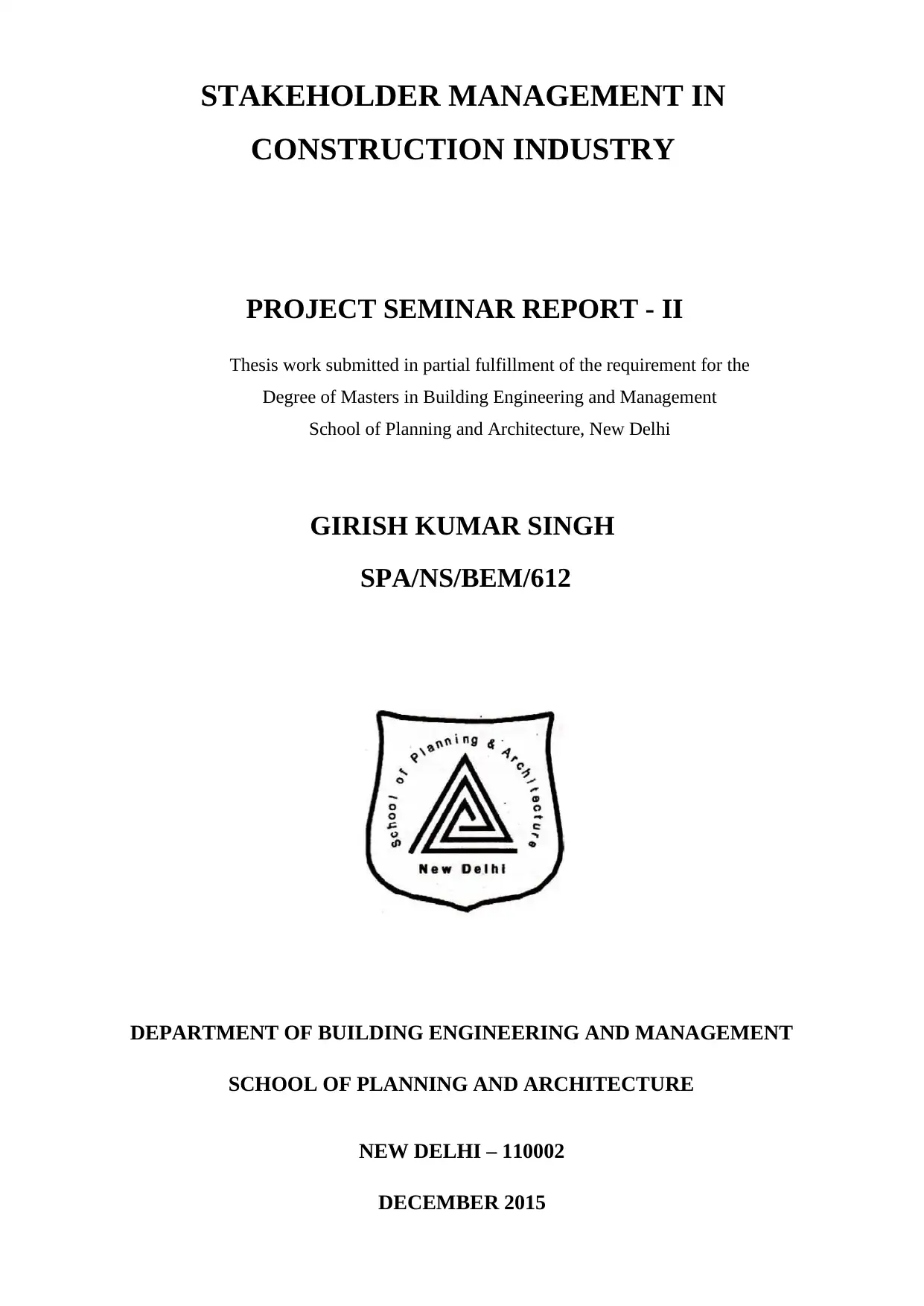
STAKEHOLDER MANAGEMENT IN
CONSTRUCTION INDUSTRY
PROJECT SEMINAR REPORT - II
Thesis work submitted in partial fulfillment of the requirement for the
Degree of Masters in Building Engineering and Management
School of Planning and Architecture, New Delhi
GIRISH KUMAR SINGH
SPA/NS/BEM/612
DEPARTMENT OF BUILDING ENGINEERING AND MANAGEMENT
SCHOOL OF PLANNING AND ARCHITECTURE
NEW DELHI – 110002
DECEMBER 2015
CONSTRUCTION INDUSTRY
PROJECT SEMINAR REPORT - II
Thesis work submitted in partial fulfillment of the requirement for the
Degree of Masters in Building Engineering and Management
School of Planning and Architecture, New Delhi
GIRISH KUMAR SINGH
SPA/NS/BEM/612
DEPARTMENT OF BUILDING ENGINEERING AND MANAGEMENT
SCHOOL OF PLANNING AND ARCHITECTURE
NEW DELHI – 110002
DECEMBER 2015
Paraphrase This Document
Need a fresh take? Get an instant paraphrase of this document with our AI Paraphraser
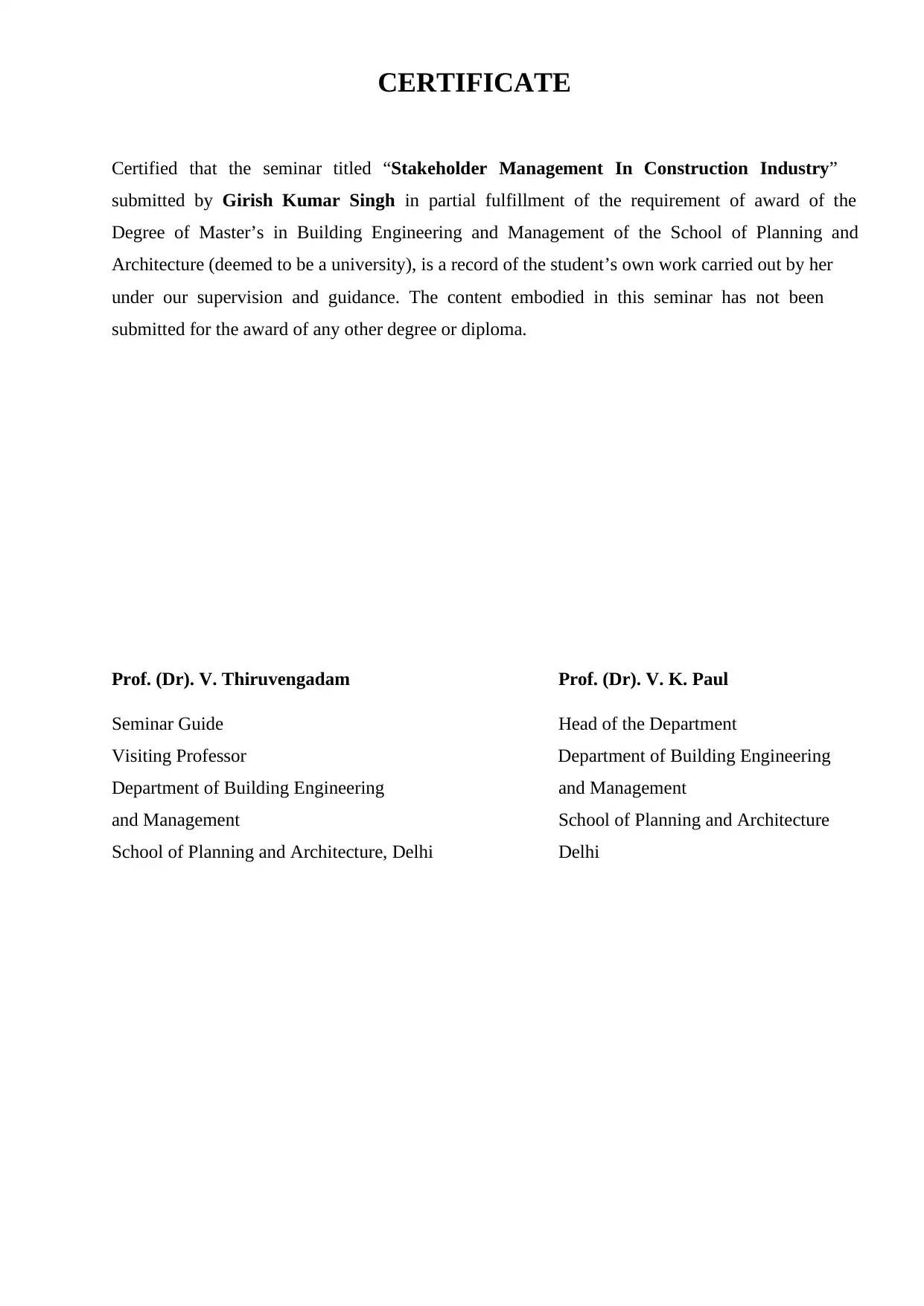
CERTIFICATE
Certified that the seminar titled “Stakeholder Management In Construction Industry”
submitted by Girish Kumar Singh in partial fulfillment of the requirement of award of the
Degree of Master’s in Building Engineering and Management of the School of Planning and
Architecture (deemed to be a university), is a record of the student’s own work carried out by her
under our supervision and guidance. The content embodied in this seminar has not been
submitted for the award of any other degree or diploma.
Prof. (Dr). V. Thiruvengadam Prof. (Dr). V. K. Paul
Seminar Guide Head of the Department
Visiting Professor Department of Building Engineering
Department of Building Engineering and Management
and Management School of Planning and Architecture
School of Planning and Architecture, Delhi Delhi
Certified that the seminar titled “Stakeholder Management In Construction Industry”
submitted by Girish Kumar Singh in partial fulfillment of the requirement of award of the
Degree of Master’s in Building Engineering and Management of the School of Planning and
Architecture (deemed to be a university), is a record of the student’s own work carried out by her
under our supervision and guidance. The content embodied in this seminar has not been
submitted for the award of any other degree or diploma.
Prof. (Dr). V. Thiruvengadam Prof. (Dr). V. K. Paul
Seminar Guide Head of the Department
Visiting Professor Department of Building Engineering
Department of Building Engineering and Management
and Management School of Planning and Architecture
School of Planning and Architecture, Delhi Delhi
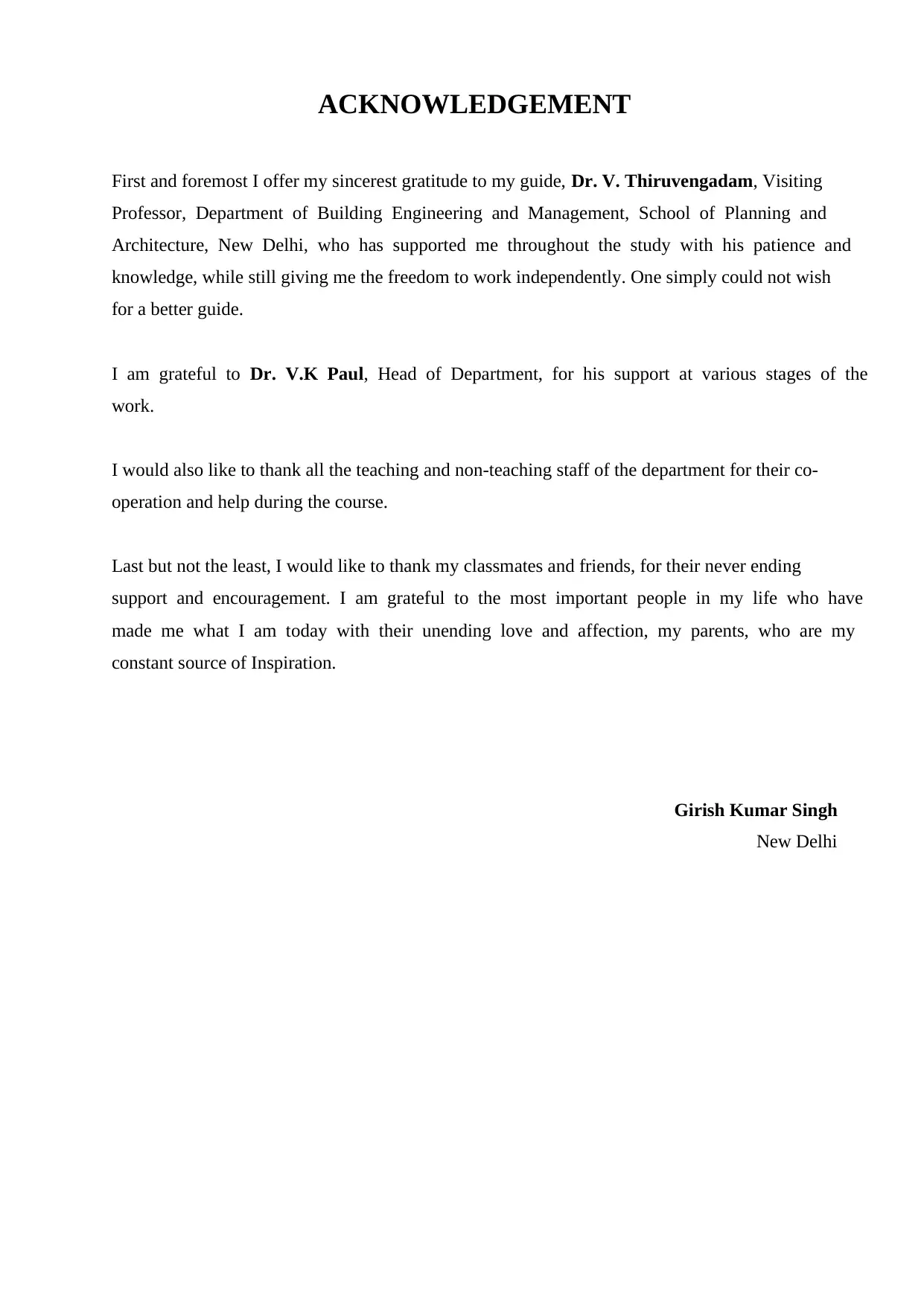
ACKNOWLEDGEMENT
First and foremost I offer my sincerest gratitude to my guide, Dr. V. Thiruvengadam, Visiting
Professor, Department of Building Engineering and Management, School of Planning and
Architecture, New Delhi, who has supported me throughout the study with his patience and
knowledge, while still giving me the freedom to work independently. One simply could not wish
for a better guide.
I am grateful to Dr. V.K Paul, Head of Department, for his support at various stages of the
work.
I would also like to thank all the teaching and non-teaching staff of the department for their co-
operation and help during the course.
Last but not the least, I would like to thank my classmates and friends, for their never ending
support and encouragement. I am grateful to the most important people in my life who have
made me what I am today with their unending love and affection, my parents, who are my
constant source of Inspiration.
Girish Kumar Singh
New Delhi
First and foremost I offer my sincerest gratitude to my guide, Dr. V. Thiruvengadam, Visiting
Professor, Department of Building Engineering and Management, School of Planning and
Architecture, New Delhi, who has supported me throughout the study with his patience and
knowledge, while still giving me the freedom to work independently. One simply could not wish
for a better guide.
I am grateful to Dr. V.K Paul, Head of Department, for his support at various stages of the
work.
I would also like to thank all the teaching and non-teaching staff of the department for their co-
operation and help during the course.
Last but not the least, I would like to thank my classmates and friends, for their never ending
support and encouragement. I am grateful to the most important people in my life who have
made me what I am today with their unending love and affection, my parents, who are my
constant source of Inspiration.
Girish Kumar Singh
New Delhi
⊘ This is a preview!⊘
Do you want full access?
Subscribe today to unlock all pages.

Trusted by 1+ million students worldwide
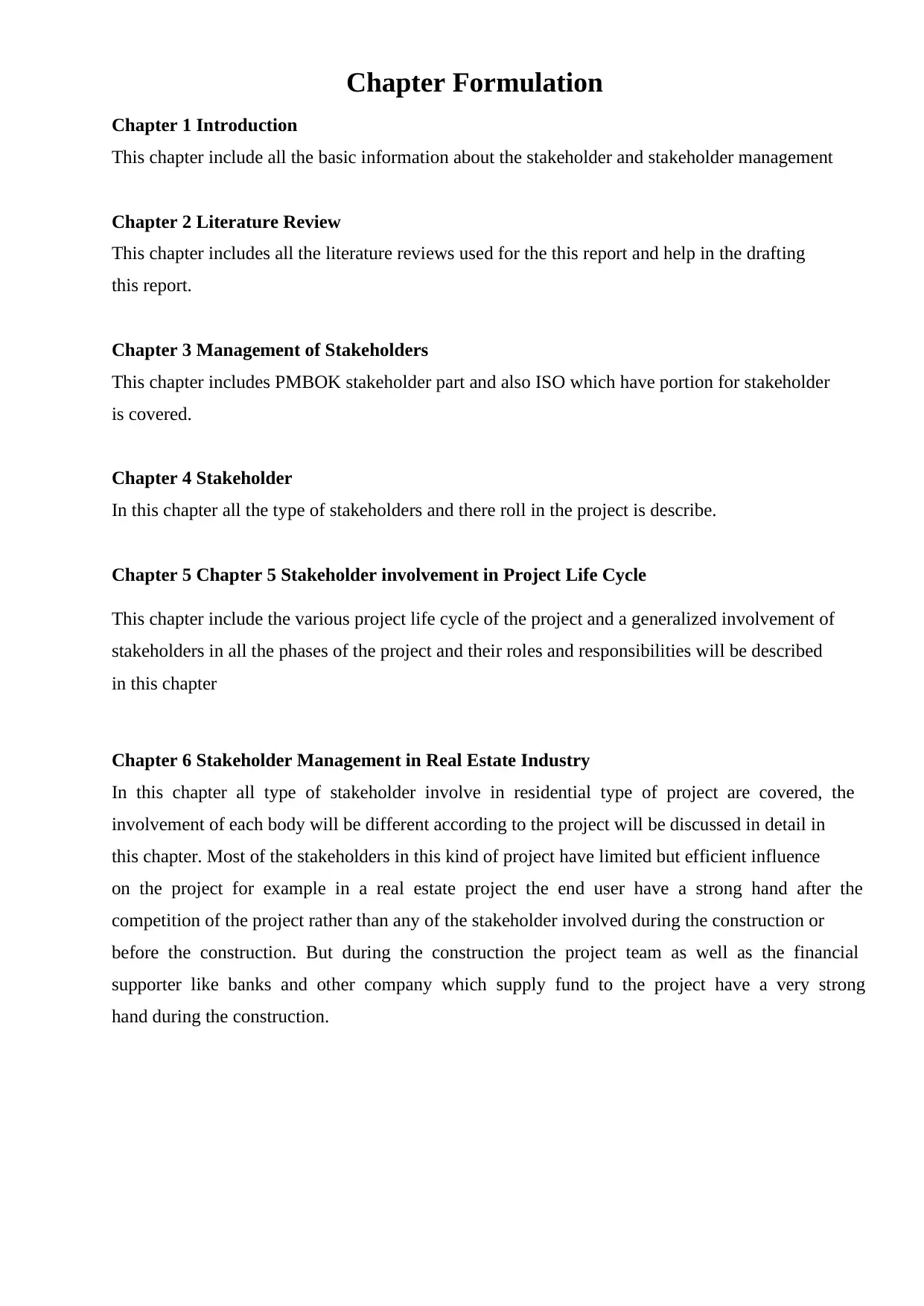
Chapter Formulation
Chapter 1 Introduction
This chapter include all the basic information about the stakeholder and stakeholder management
Chapter 2 Literature Review
This chapter includes all the literature reviews used for the this report and help in the drafting
this report.
Chapter 3 Management of Stakeholders
This chapter includes PMBOK stakeholder part and also ISO which have portion for stakeholder
is covered.
Chapter 4 Stakeholder
In this chapter all the type of stakeholders and there roll in the project is describe.
Chapter 5 Chapter 5 Stakeholder involvement in Project Life Cycle
This chapter include the various project life cycle of the project and a generalized involvement of
stakeholders in all the phases of the project and their roles and responsibilities will be described
in this chapter
Chapter 6 Stakeholder Management in Real Estate Industry
In this chapter all type of stakeholder involve in residential type of project are covered, the
involvement of each body will be different according to the project will be discussed in detail in
this chapter. Most of the stakeholders in this kind of project have limited but efficient influence
on the project for example in a real estate project the end user have a strong hand after the
competition of the project rather than any of the stakeholder involved during the construction or
before the construction. But during the construction the project team as well as the financial
supporter like banks and other company which supply fund to the project have a very strong
hand during the construction.
Chapter 1 Introduction
This chapter include all the basic information about the stakeholder and stakeholder management
Chapter 2 Literature Review
This chapter includes all the literature reviews used for the this report and help in the drafting
this report.
Chapter 3 Management of Stakeholders
This chapter includes PMBOK stakeholder part and also ISO which have portion for stakeholder
is covered.
Chapter 4 Stakeholder
In this chapter all the type of stakeholders and there roll in the project is describe.
Chapter 5 Chapter 5 Stakeholder involvement in Project Life Cycle
This chapter include the various project life cycle of the project and a generalized involvement of
stakeholders in all the phases of the project and their roles and responsibilities will be described
in this chapter
Chapter 6 Stakeholder Management in Real Estate Industry
In this chapter all type of stakeholder involve in residential type of project are covered, the
involvement of each body will be different according to the project will be discussed in detail in
this chapter. Most of the stakeholders in this kind of project have limited but efficient influence
on the project for example in a real estate project the end user have a strong hand after the
competition of the project rather than any of the stakeholder involved during the construction or
before the construction. But during the construction the project team as well as the financial
supporter like banks and other company which supply fund to the project have a very strong
hand during the construction.
Paraphrase This Document
Need a fresh take? Get an instant paraphrase of this document with our AI Paraphraser
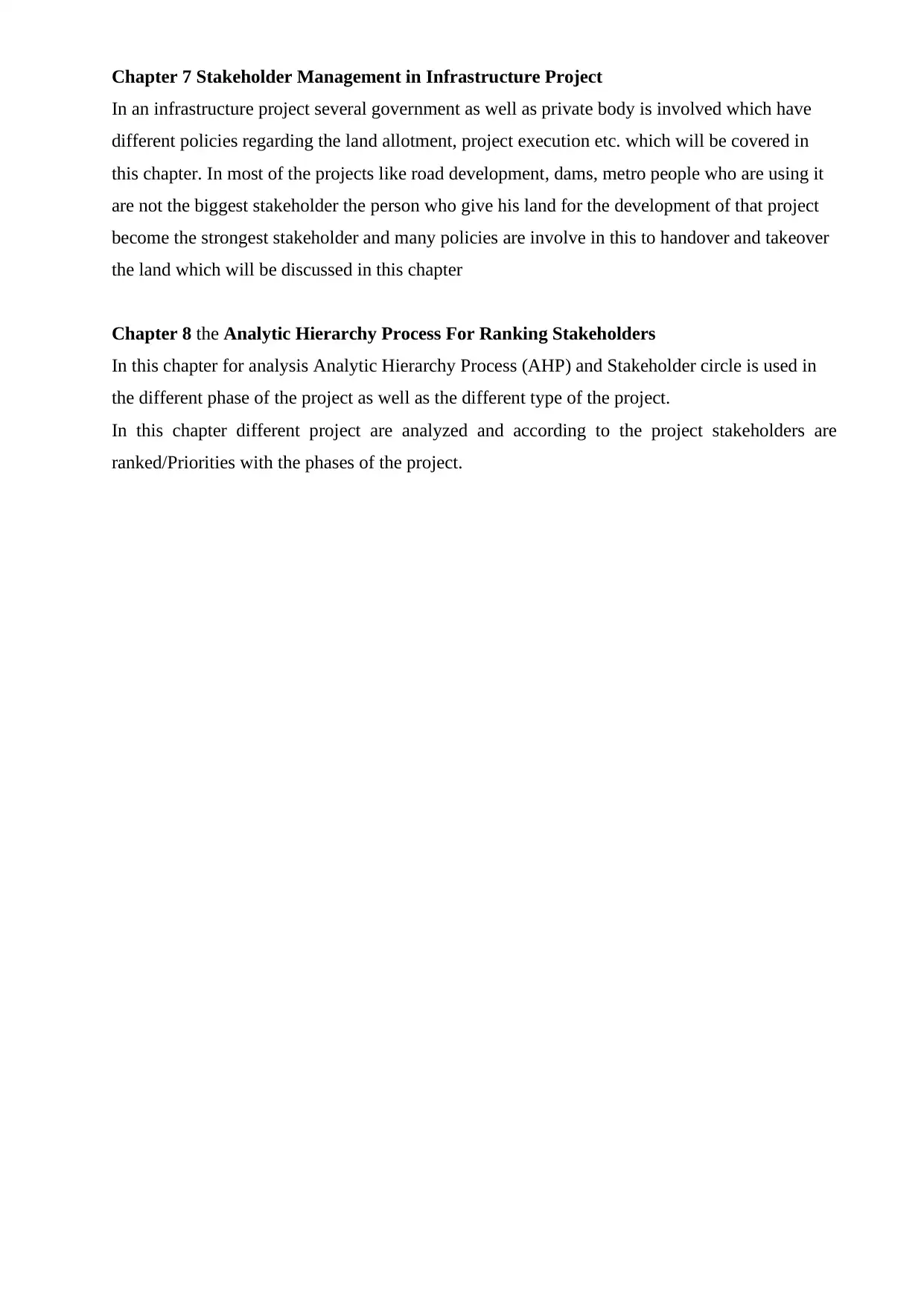
Chapter 7 Stakeholder Management in Infrastructure Project
In an infrastructure project several government as well as private body is involved which have
different policies regarding the land allotment, project execution etc. which will be covered in
this chapter. In most of the projects like road development, dams, metro people who are using it
are not the biggest stakeholder the person who give his land for the development of that project
become the strongest stakeholder and many policies are involve in this to handover and takeover
the land which will be discussed in this chapter
Chapter 8 the Analytic Hierarchy Process For Ranking Stakeholders
In this chapter for analysis Analytic Hierarchy Process (AHP) and Stakeholder circle is used in
the different phase of the project as well as the different type of the project.
In this chapter different project are analyzed and according to the project stakeholders are
ranked/Priorities with the phases of the project.
In an infrastructure project several government as well as private body is involved which have
different policies regarding the land allotment, project execution etc. which will be covered in
this chapter. In most of the projects like road development, dams, metro people who are using it
are not the biggest stakeholder the person who give his land for the development of that project
become the strongest stakeholder and many policies are involve in this to handover and takeover
the land which will be discussed in this chapter
Chapter 8 the Analytic Hierarchy Process For Ranking Stakeholders
In this chapter for analysis Analytic Hierarchy Process (AHP) and Stakeholder circle is used in
the different phase of the project as well as the different type of the project.
In this chapter different project are analyzed and according to the project stakeholders are
ranked/Priorities with the phases of the project.
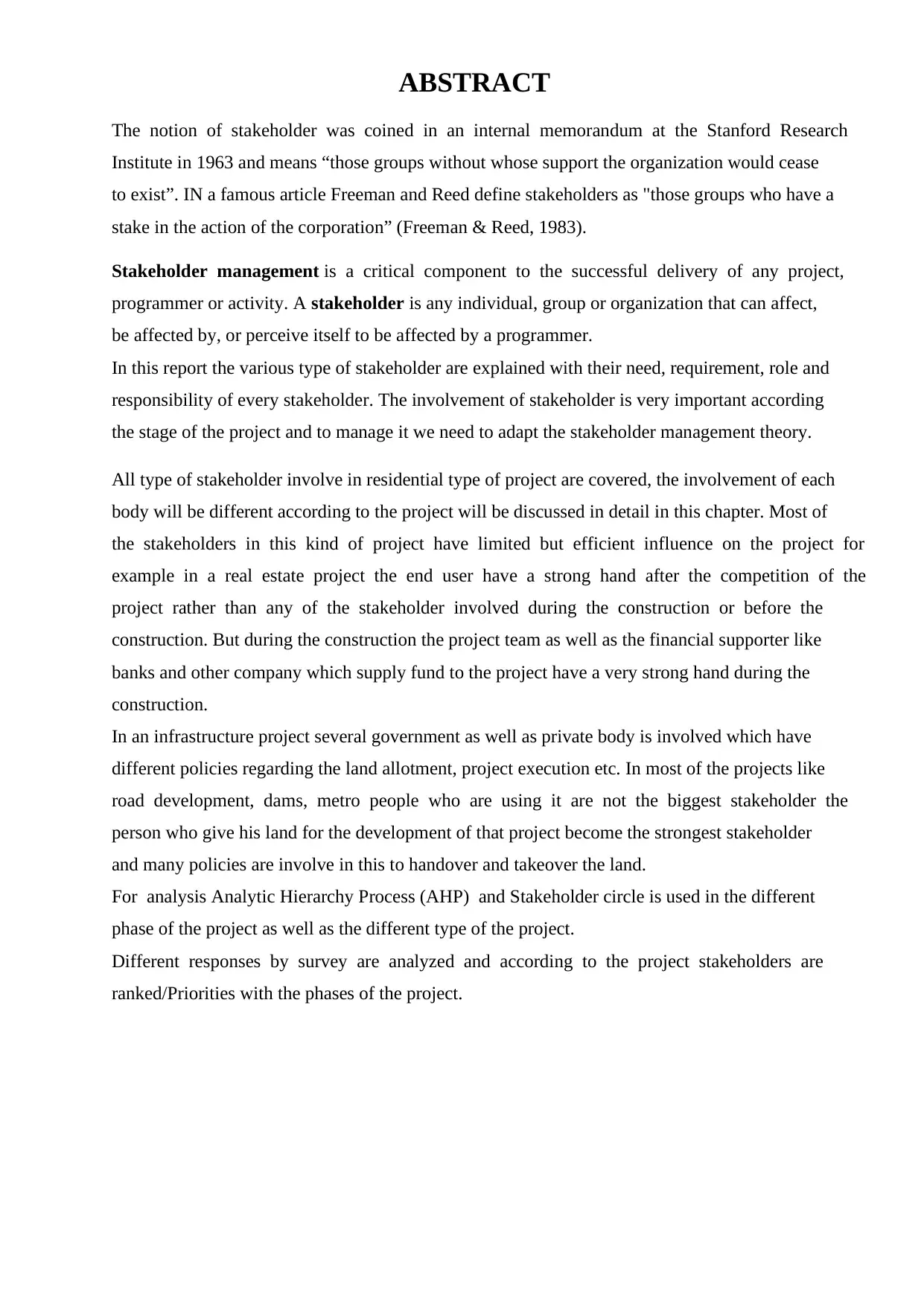
ABSTRACT
The notion of stakeholder was coined in an internal memorandum at the Stanford Research
Institute in 1963 and means “those groups without whose support the organization would cease
to exist”. IN a famous article Freeman and Reed define stakeholders as "those groups who have a
stake in the action of the corporation” (Freeman & Reed, 1983).
Stakeholder management is a critical component to the successful delivery of any project,
programmer or activity. A stakeholder is any individual, group or organization that can affect,
be affected by, or perceive itself to be affected by a programmer.
In this report the various type of stakeholder are explained with their need, requirement, role and
responsibility of every stakeholder. The involvement of stakeholder is very important according
the stage of the project and to manage it we need to adapt the stakeholder management theory.
All type of stakeholder involve in residential type of project are covered, the involvement of each
body will be different according to the project will be discussed in detail in this chapter. Most of
the stakeholders in this kind of project have limited but efficient influence on the project for
example in a real estate project the end user have a strong hand after the competition of the
project rather than any of the stakeholder involved during the construction or before the
construction. But during the construction the project team as well as the financial supporter like
banks and other company which supply fund to the project have a very strong hand during the
construction.
In an infrastructure project several government as well as private body is involved which have
different policies regarding the land allotment, project execution etc. In most of the projects like
road development, dams, metro people who are using it are not the biggest stakeholder the
person who give his land for the development of that project become the strongest stakeholder
and many policies are involve in this to handover and takeover the land.
For analysis Analytic Hierarchy Process (AHP) and Stakeholder circle is used in the different
phase of the project as well as the different type of the project.
Different responses by survey are analyzed and according to the project stakeholders are
ranked/Priorities with the phases of the project.
The notion of stakeholder was coined in an internal memorandum at the Stanford Research
Institute in 1963 and means “those groups without whose support the organization would cease
to exist”. IN a famous article Freeman and Reed define stakeholders as "those groups who have a
stake in the action of the corporation” (Freeman & Reed, 1983).
Stakeholder management is a critical component to the successful delivery of any project,
programmer or activity. A stakeholder is any individual, group or organization that can affect,
be affected by, or perceive itself to be affected by a programmer.
In this report the various type of stakeholder are explained with their need, requirement, role and
responsibility of every stakeholder. The involvement of stakeholder is very important according
the stage of the project and to manage it we need to adapt the stakeholder management theory.
All type of stakeholder involve in residential type of project are covered, the involvement of each
body will be different according to the project will be discussed in detail in this chapter. Most of
the stakeholders in this kind of project have limited but efficient influence on the project for
example in a real estate project the end user have a strong hand after the competition of the
project rather than any of the stakeholder involved during the construction or before the
construction. But during the construction the project team as well as the financial supporter like
banks and other company which supply fund to the project have a very strong hand during the
construction.
In an infrastructure project several government as well as private body is involved which have
different policies regarding the land allotment, project execution etc. In most of the projects like
road development, dams, metro people who are using it are not the biggest stakeholder the
person who give his land for the development of that project become the strongest stakeholder
and many policies are involve in this to handover and takeover the land.
For analysis Analytic Hierarchy Process (AHP) and Stakeholder circle is used in the different
phase of the project as well as the different type of the project.
Different responses by survey are analyzed and according to the project stakeholders are
ranked/Priorities with the phases of the project.
⊘ This is a preview!⊘
Do you want full access?
Subscribe today to unlock all pages.

Trusted by 1+ million students worldwide
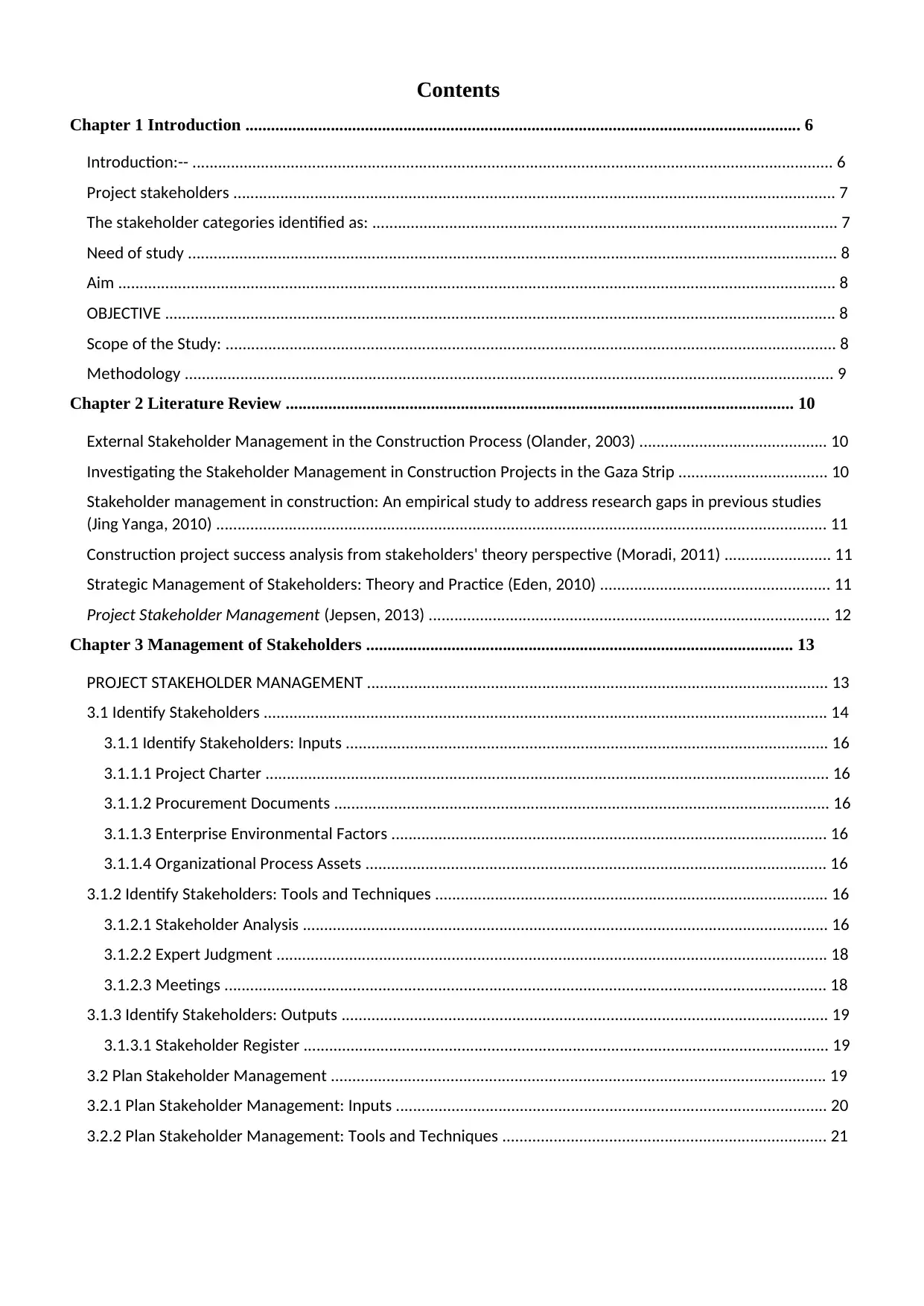
Contents
Chapter 1 Introduction .................................................................................................................................. 6
Introduction:-- ...................................................................................................................................................... 6
Project stakeholders ............................................................................................................................................. 7
The stakeholder categories identified as: ............................................................................................................. 7
Need of study ........................................................................................................................................................ 8
Aim ........................................................................................................................................................................ 8
OBJECTIVE ............................................................................................................................................................. 8
Scope of the Study: ............................................................................................................................................... 8
Methodology ........................................................................................................................................................ 9
Chapter 2 Literature Review ....................................................................................................................... 10
External Stakeholder Management in the Construction Process (Olander, 2003) ............................................ 10
Investigating the Stakeholder Management in Construction Projects in the Gaza Strip ................................... 10
Stakeholder management in construction: An empirical study to address research gaps in previous studies
(Jing Yanga, 2010) ............................................................................................................................................... 11
Construction project success analysis from stakeholders' theory perspective (Moradi, 2011) ......................... 11
Strategic Management of Stakeholders: Theory and Practice (Eden, 2010) ...................................................... 11
Project Stakeholder Management (Jepsen, 2013) .............................................................................................. 12
Chapter 3 Management of Stakeholders .................................................................................................... 13
PROJECT STAKEHOLDER MANAGEMENT ............................................................................................................ 13
3.1 Identify Stakeholders .................................................................................................................................... 14
3.1.1 Identify Stakeholders: Inputs ................................................................................................................. 16
3.1.1.1 Project Charter .................................................................................................................................... 16
3.1.1.2 Procurement Documents .................................................................................................................... 16
3.1.1.3 Enterprise Environmental Factors ...................................................................................................... 16
3.1.1.4 Organizational Process Assets ............................................................................................................ 16
3.1.2 Identify Stakeholders: Tools and Techniques ............................................................................................ 16
3.1.2.1 Stakeholder Analysis ........................................................................................................................... 16
3.1.2.2 Expert Judgment ................................................................................................................................. 18
3.1.2.3 Meetings ............................................................................................................................................. 18
3.1.3 Identify Stakeholders: Outputs .................................................................................................................. 19
3.1.3.1 Stakeholder Register ........................................................................................................................... 19
3.2 Plan Stakeholder Management .................................................................................................................... 19
3.2.1 Plan Stakeholder Management: Inputs ..................................................................................................... 20
3.2.2 Plan Stakeholder Management: Tools and Techniques ............................................................................ 21
Chapter 1 Introduction .................................................................................................................................. 6
Introduction:-- ...................................................................................................................................................... 6
Project stakeholders ............................................................................................................................................. 7
The stakeholder categories identified as: ............................................................................................................. 7
Need of study ........................................................................................................................................................ 8
Aim ........................................................................................................................................................................ 8
OBJECTIVE ............................................................................................................................................................. 8
Scope of the Study: ............................................................................................................................................... 8
Methodology ........................................................................................................................................................ 9
Chapter 2 Literature Review ....................................................................................................................... 10
External Stakeholder Management in the Construction Process (Olander, 2003) ............................................ 10
Investigating the Stakeholder Management in Construction Projects in the Gaza Strip ................................... 10
Stakeholder management in construction: An empirical study to address research gaps in previous studies
(Jing Yanga, 2010) ............................................................................................................................................... 11
Construction project success analysis from stakeholders' theory perspective (Moradi, 2011) ......................... 11
Strategic Management of Stakeholders: Theory and Practice (Eden, 2010) ...................................................... 11
Project Stakeholder Management (Jepsen, 2013) .............................................................................................. 12
Chapter 3 Management of Stakeholders .................................................................................................... 13
PROJECT STAKEHOLDER MANAGEMENT ............................................................................................................ 13
3.1 Identify Stakeholders .................................................................................................................................... 14
3.1.1 Identify Stakeholders: Inputs ................................................................................................................. 16
3.1.1.1 Project Charter .................................................................................................................................... 16
3.1.1.2 Procurement Documents .................................................................................................................... 16
3.1.1.3 Enterprise Environmental Factors ...................................................................................................... 16
3.1.1.4 Organizational Process Assets ............................................................................................................ 16
3.1.2 Identify Stakeholders: Tools and Techniques ............................................................................................ 16
3.1.2.1 Stakeholder Analysis ........................................................................................................................... 16
3.1.2.2 Expert Judgment ................................................................................................................................. 18
3.1.2.3 Meetings ............................................................................................................................................. 18
3.1.3 Identify Stakeholders: Outputs .................................................................................................................. 19
3.1.3.1 Stakeholder Register ........................................................................................................................... 19
3.2 Plan Stakeholder Management .................................................................................................................... 19
3.2.1 Plan Stakeholder Management: Inputs ..................................................................................................... 20
3.2.2 Plan Stakeholder Management: Tools and Techniques ............................................................................ 21
Paraphrase This Document
Need a fresh take? Get an instant paraphrase of this document with our AI Paraphraser
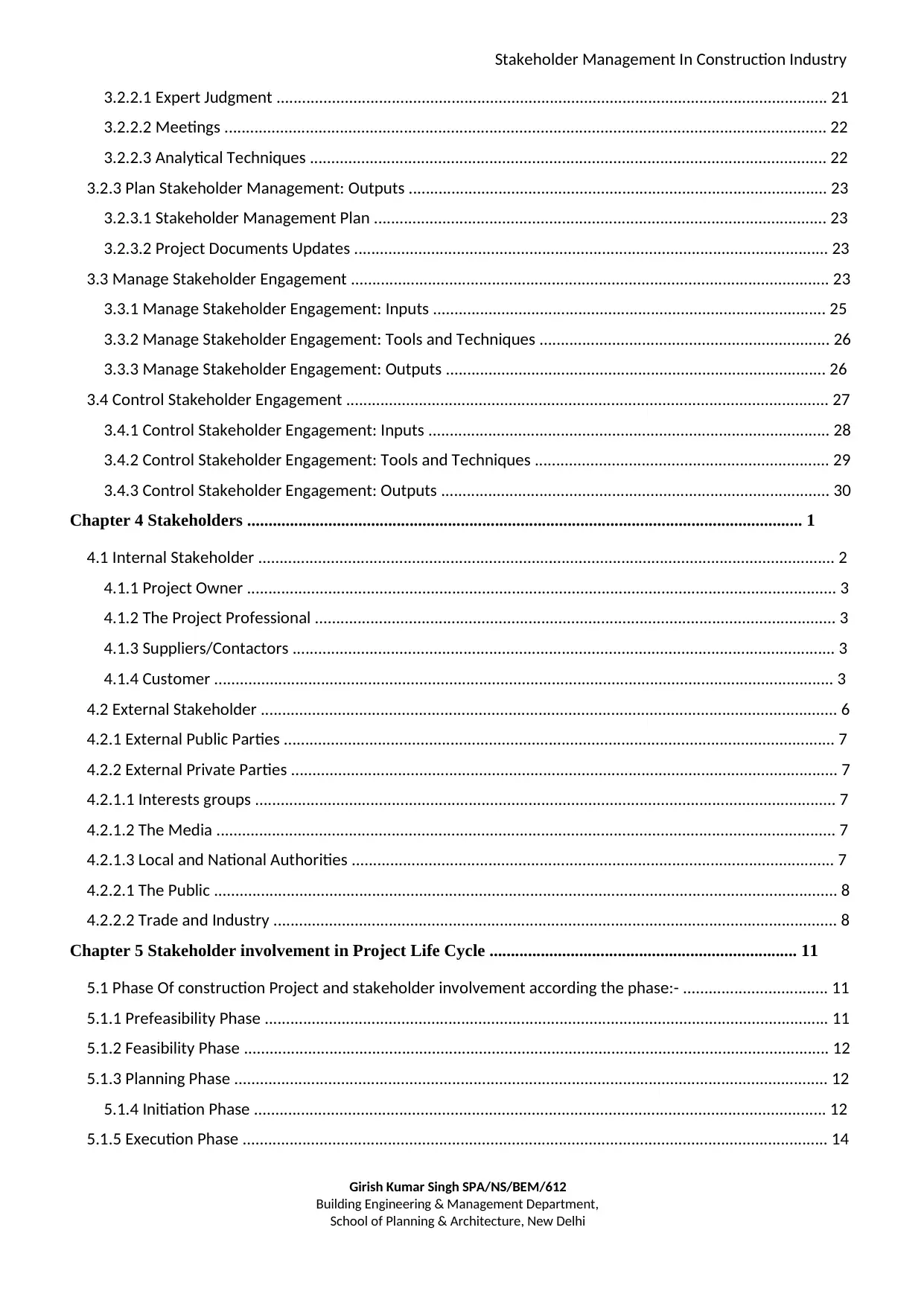
Stakeholder Management In Construction Industry
Girish Kumar Singh SPA/NS/BEM/612
Building Engineering & Management Department,
School of Planning & Architecture, New Delhi
3.2.2.1 Expert Judgment ................................................................................................................................. 21
3.2.2.2 Meetings ............................................................................................................................................. 22
3.2.2.3 Analytical Techniques ......................................................................................................................... 22
3.2.3 Plan Stakeholder Management: Outputs .................................................................................................. 23
3.2.3.1 Stakeholder Management Plan .......................................................................................................... 23
3.2.3.2 Project Documents Updates ............................................................................................................... 23
3.3 Manage Stakeholder Engagement ................................................................................................................ 23
3.3.1 Manage Stakeholder Engagement: Inputs ............................................................................................ 25
3.3.2 Manage Stakeholder Engagement: Tools and Techniques .................................................................... 26
3.3.3 Manage Stakeholder Engagement: Outputs ......................................................................................... 26
3.4 Control Stakeholder Engagement ................................................................................................................. 27
3.4.1 Control Stakeholder Engagement: Inputs .............................................................................................. 28
3.4.2 Control Stakeholder Engagement: Tools and Techniques ..................................................................... 29
3.4.3 Control Stakeholder Engagement: Outputs ........................................................................................... 30
Chapter 4 Stakeholders .................................................................................................................................. 1
4.1 Internal Stakeholder ....................................................................................................................................... 2
4.1.1 Project Owner .......................................................................................................................................... 3
4.1.2 The Project Professional .......................................................................................................................... 3
4.1.3 Suppliers/Contactors ............................................................................................................................... 3
4.1.4 Customer ................................................................................................................................................. 3
4.2 External Stakeholder ....................................................................................................................................... 6
4.2.1 External Public Parties ................................................................................................................................. 7
4.2.2 External Private Parties ................................................................................................................................ 7
4.2.1.1 Interests groups ........................................................................................................................................ 7
4.2.1.2 The Media ................................................................................................................................................. 7
4.2.1.3 Local and National Authorities ................................................................................................................. 7
4.2.2.1 The Public .................................................................................................................................................. 8
4.2.2.2 Trade and Industry .................................................................................................................................... 8
Chapter 5 Stakeholder involvement in Project Life Cycle ........................................................................ 11
5.1 Phase Of construction Project and stakeholder involvement according the phase:- .................................. 11
5.1.1 Prefeasibility Phase .................................................................................................................................... 11
5.1.2 Feasibility Phase ......................................................................................................................................... 12
5.1.3 Planning Phase ........................................................................................................................................... 12
5.1.4 Initiation Phase ...................................................................................................................................... 12
5.1.5 Execution Phase ......................................................................................................................................... 14
Girish Kumar Singh SPA/NS/BEM/612
Building Engineering & Management Department,
School of Planning & Architecture, New Delhi
3.2.2.1 Expert Judgment ................................................................................................................................. 21
3.2.2.2 Meetings ............................................................................................................................................. 22
3.2.2.3 Analytical Techniques ......................................................................................................................... 22
3.2.3 Plan Stakeholder Management: Outputs .................................................................................................. 23
3.2.3.1 Stakeholder Management Plan .......................................................................................................... 23
3.2.3.2 Project Documents Updates ............................................................................................................... 23
3.3 Manage Stakeholder Engagement ................................................................................................................ 23
3.3.1 Manage Stakeholder Engagement: Inputs ............................................................................................ 25
3.3.2 Manage Stakeholder Engagement: Tools and Techniques .................................................................... 26
3.3.3 Manage Stakeholder Engagement: Outputs ......................................................................................... 26
3.4 Control Stakeholder Engagement ................................................................................................................. 27
3.4.1 Control Stakeholder Engagement: Inputs .............................................................................................. 28
3.4.2 Control Stakeholder Engagement: Tools and Techniques ..................................................................... 29
3.4.3 Control Stakeholder Engagement: Outputs ........................................................................................... 30
Chapter 4 Stakeholders .................................................................................................................................. 1
4.1 Internal Stakeholder ....................................................................................................................................... 2
4.1.1 Project Owner .......................................................................................................................................... 3
4.1.2 The Project Professional .......................................................................................................................... 3
4.1.3 Suppliers/Contactors ............................................................................................................................... 3
4.1.4 Customer ................................................................................................................................................. 3
4.2 External Stakeholder ....................................................................................................................................... 6
4.2.1 External Public Parties ................................................................................................................................. 7
4.2.2 External Private Parties ................................................................................................................................ 7
4.2.1.1 Interests groups ........................................................................................................................................ 7
4.2.1.2 The Media ................................................................................................................................................. 7
4.2.1.3 Local and National Authorities ................................................................................................................. 7
4.2.2.1 The Public .................................................................................................................................................. 8
4.2.2.2 Trade and Industry .................................................................................................................................... 8
Chapter 5 Stakeholder involvement in Project Life Cycle ........................................................................ 11
5.1 Phase Of construction Project and stakeholder involvement according the phase:- .................................. 11
5.1.1 Prefeasibility Phase .................................................................................................................................... 11
5.1.2 Feasibility Phase ......................................................................................................................................... 12
5.1.3 Planning Phase ........................................................................................................................................... 12
5.1.4 Initiation Phase ...................................................................................................................................... 12
5.1.5 Execution Phase ......................................................................................................................................... 14
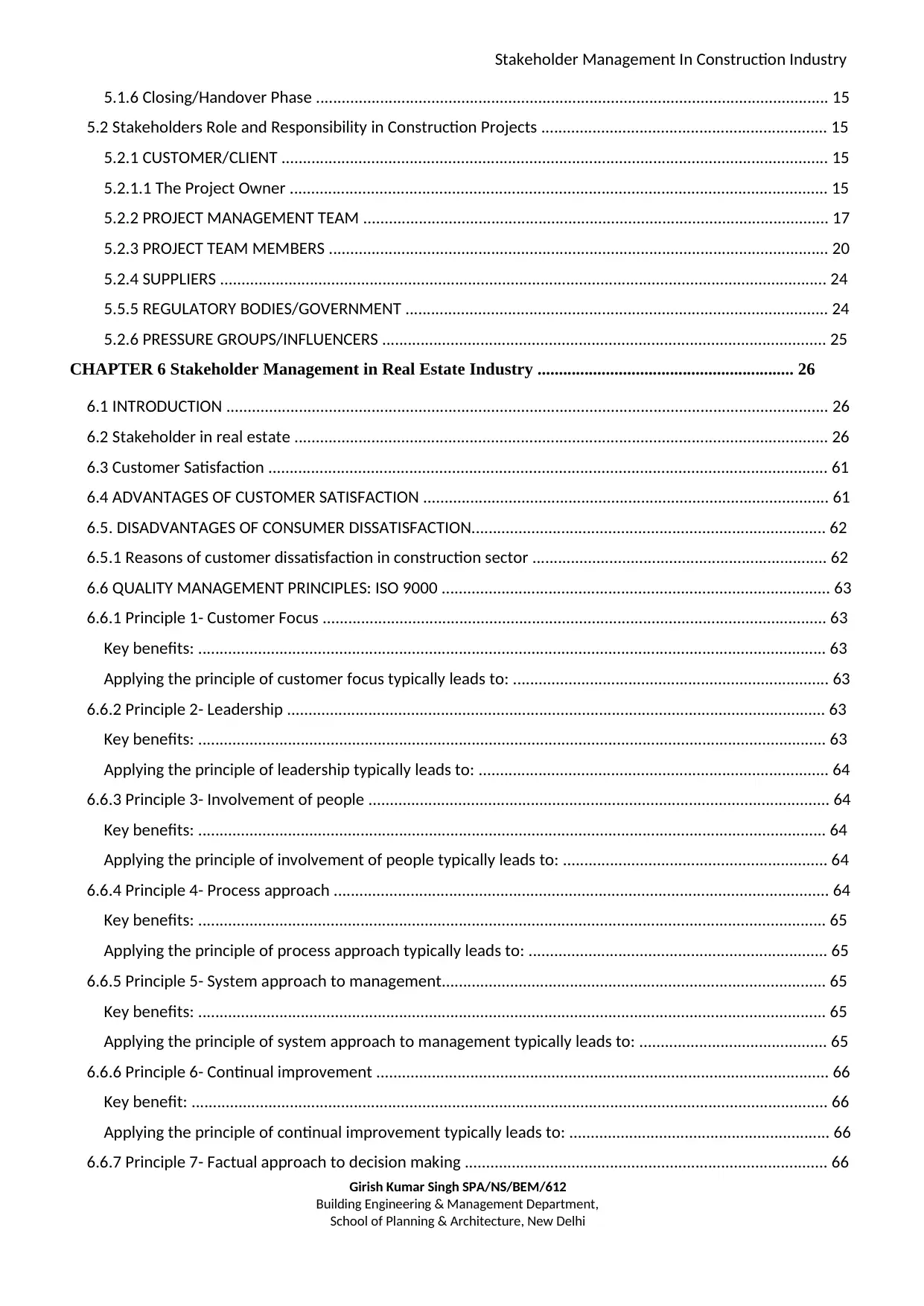
Stakeholder Management In Construction Industry
Girish Kumar Singh SPA/NS/BEM/612
Building Engineering & Management Department,
School of Planning & Architecture, New Delhi
5.1.6 Closing/Handover Phase ........................................................................................................................ 15
5.2 Stakeholders Role and Responsibility in Construction Projects ................................................................... 15
5.2.1 CUSTOMER/CLIENT ................................................................................................................................ 15
5.2.1.1 The Project Owner .............................................................................................................................. 15
5.2.2 PROJECT MANAGEMENT TEAM ............................................................................................................. 17
5.2.3 PROJECT TEAM MEMBERS ..................................................................................................................... 20
5.2.4 SUPPLIERS .............................................................................................................................................. 24
5.5.5 REGULATORY BODIES/GOVERNMENT ................................................................................................... 24
5.2.6 PRESSURE GROUPS/INFLUENCERS ........................................................................................................ 25
CHAPTER 6 Stakeholder Management in Real Estate Industry ............................................................ 26
6.1 INTRODUCTION ............................................................................................................................................. 26
6.2 Stakeholder in real estate ............................................................................................................................. 26
6.3 Customer Satisfaction ................................................................................................................................... 61
6.4 ADVANTAGES OF CUSTOMER SATISFACTION ............................................................................................... 61
6.5. DISADVANTAGES OF CONSUMER DISSATISFACTION................................................................................... 62
6.5.1 Reasons of customer dissatisfaction in construction sector ..................................................................... 62
6.6 QUALITY MANAGEMENT PRINCIPLES: ISO 9000 ........................................................................................... 63
6.6.1 Principle 1- Customer Focus ...................................................................................................................... 63
Key benefits: ................................................................................................................................................... 63
Applying the principle of customer focus typically leads to: .......................................................................... 63
6.6.2 Principle 2- Leadership .............................................................................................................................. 63
Key benefits: ................................................................................................................................................... 63
Applying the principle of leadership typically leads to: .................................................................................. 64
6.6.3 Principle 3- Involvement of people ............................................................................................................ 64
Key benefits: ................................................................................................................................................... 64
Applying the principle of involvement of people typically leads to: .............................................................. 64
6.6.4 Principle 4- Process approach .................................................................................................................... 64
Key benefits: ................................................................................................................................................... 65
Applying the principle of process approach typically leads to: ...................................................................... 65
6.6.5 Principle 5- System approach to management.......................................................................................... 65
Key benefits: ................................................................................................................................................... 65
Applying the principle of system approach to management typically leads to: ............................................ 65
6.6.6 Principle 6- Continual improvement .......................................................................................................... 66
Key benefit: ..................................................................................................................................................... 66
Applying the principle of continual improvement typically leads to: ............................................................. 66
6.6.7 Principle 7- Factual approach to decision making ..................................................................................... 66
Girish Kumar Singh SPA/NS/BEM/612
Building Engineering & Management Department,
School of Planning & Architecture, New Delhi
5.1.6 Closing/Handover Phase ........................................................................................................................ 15
5.2 Stakeholders Role and Responsibility in Construction Projects ................................................................... 15
5.2.1 CUSTOMER/CLIENT ................................................................................................................................ 15
5.2.1.1 The Project Owner .............................................................................................................................. 15
5.2.2 PROJECT MANAGEMENT TEAM ............................................................................................................. 17
5.2.3 PROJECT TEAM MEMBERS ..................................................................................................................... 20
5.2.4 SUPPLIERS .............................................................................................................................................. 24
5.5.5 REGULATORY BODIES/GOVERNMENT ................................................................................................... 24
5.2.6 PRESSURE GROUPS/INFLUENCERS ........................................................................................................ 25
CHAPTER 6 Stakeholder Management in Real Estate Industry ............................................................ 26
6.1 INTRODUCTION ............................................................................................................................................. 26
6.2 Stakeholder in real estate ............................................................................................................................. 26
6.3 Customer Satisfaction ................................................................................................................................... 61
6.4 ADVANTAGES OF CUSTOMER SATISFACTION ............................................................................................... 61
6.5. DISADVANTAGES OF CONSUMER DISSATISFACTION................................................................................... 62
6.5.1 Reasons of customer dissatisfaction in construction sector ..................................................................... 62
6.6 QUALITY MANAGEMENT PRINCIPLES: ISO 9000 ........................................................................................... 63
6.6.1 Principle 1- Customer Focus ...................................................................................................................... 63
Key benefits: ................................................................................................................................................... 63
Applying the principle of customer focus typically leads to: .......................................................................... 63
6.6.2 Principle 2- Leadership .............................................................................................................................. 63
Key benefits: ................................................................................................................................................... 63
Applying the principle of leadership typically leads to: .................................................................................. 64
6.6.3 Principle 3- Involvement of people ............................................................................................................ 64
Key benefits: ................................................................................................................................................... 64
Applying the principle of involvement of people typically leads to: .............................................................. 64
6.6.4 Principle 4- Process approach .................................................................................................................... 64
Key benefits: ................................................................................................................................................... 65
Applying the principle of process approach typically leads to: ...................................................................... 65
6.6.5 Principle 5- System approach to management.......................................................................................... 65
Key benefits: ................................................................................................................................................... 65
Applying the principle of system approach to management typically leads to: ............................................ 65
6.6.6 Principle 6- Continual improvement .......................................................................................................... 66
Key benefit: ..................................................................................................................................................... 66
Applying the principle of continual improvement typically leads to: ............................................................. 66
6.6.7 Principle 7- Factual approach to decision making ..................................................................................... 66
⊘ This is a preview!⊘
Do you want full access?
Subscribe today to unlock all pages.

Trusted by 1+ million students worldwide
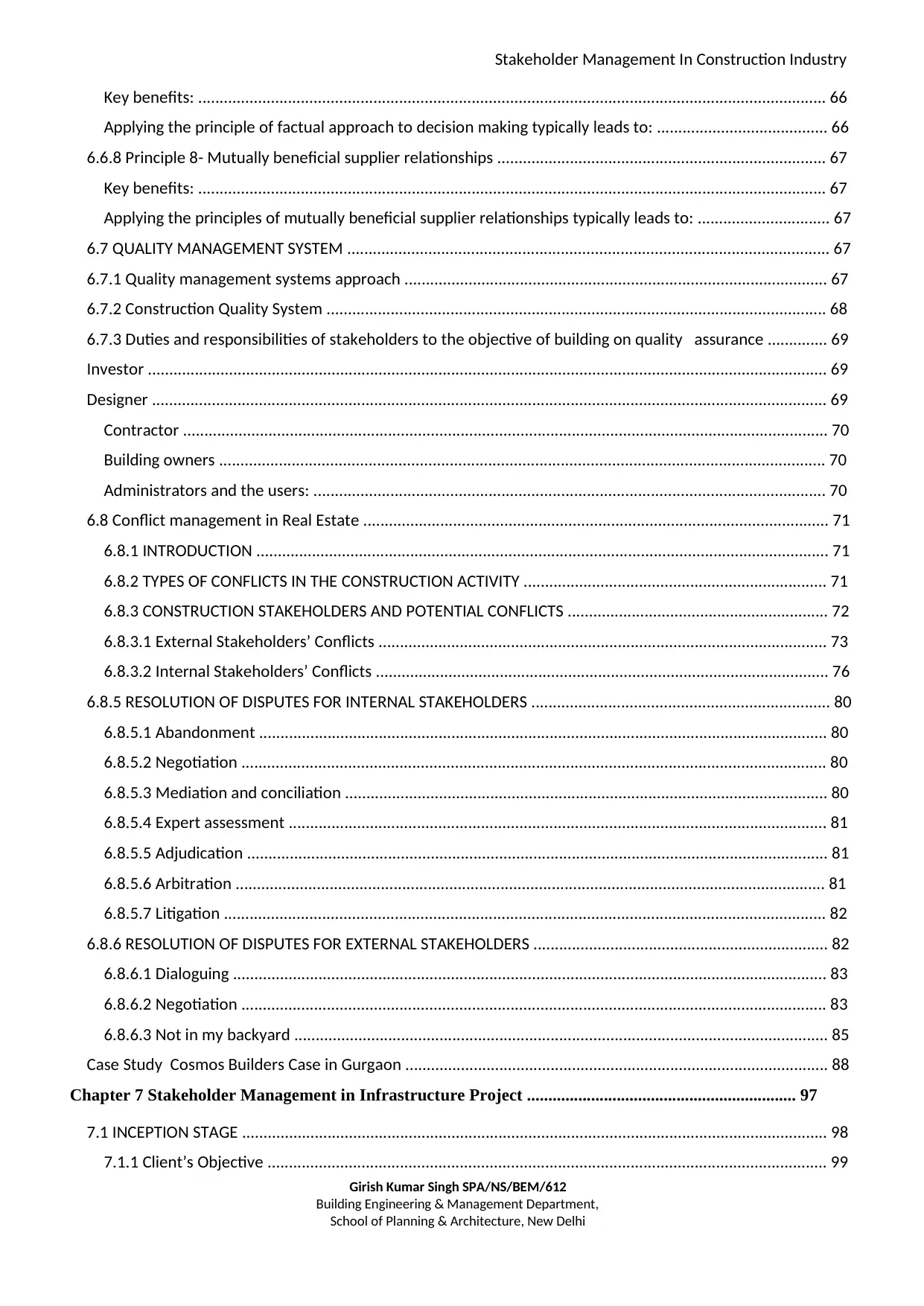
Stakeholder Management In Construction Industry
Girish Kumar Singh SPA/NS/BEM/612
Building Engineering & Management Department,
School of Planning & Architecture, New Delhi
Key benefits: ................................................................................................................................................... 66
Applying the principle of factual approach to decision making typically leads to: ........................................ 66
6.6.8 Principle 8- Mutually beneficial supplier relationships ............................................................................. 67
Key benefits: ................................................................................................................................................... 67
Applying the principles of mutually beneficial supplier relationships typically leads to: ............................... 67
6.7 QUALITY MANAGEMENT SYSTEM ................................................................................................................. 67
6.7.1 Quality management systems approach ................................................................................................... 67
6.7.2 Construction Quality System ..................................................................................................................... 68
6.7.3 Duties and responsibilities of stakeholders to the objective of building on quality assurance .............. 69
Investor ............................................................................................................................................................... 69
Designer .............................................................................................................................................................. 69
Contractor ....................................................................................................................................................... 70
Building owners .............................................................................................................................................. 70
Administrators and the users: ........................................................................................................................ 70
6.8 Conflict management in Real Estate ............................................................................................................. 71
6.8.1 INTRODUCTION ...................................................................................................................................... 71
6.8.2 TYPES OF CONFLICTS IN THE CONSTRUCTION ACTIVITY ....................................................................... 71
6.8.3 CONSTRUCTION STAKEHOLDERS AND POTENTIAL CONFLICTS ............................................................. 72
6.8.3.1 External Stakeholders’ Conflicts ......................................................................................................... 73
6.8.3.2 Internal Stakeholders’ Conflicts .......................................................................................................... 76
6.8.5 RESOLUTION OF DISPUTES FOR INTERNAL STAKEHOLDERS ...................................................................... 80
6.8.5.1 Abandonment ..................................................................................................................................... 80
6.8.5.2 Negotiation ......................................................................................................................................... 80
6.8.5.3 Mediation and conciliation ................................................................................................................. 80
6.8.5.4 Expert assessment .............................................................................................................................. 81
6.8.5.5 Adjudication ........................................................................................................................................ 81
6.8.5.6 Arbitration .......................................................................................................................................... 81
6.8.5.7 Litigation ............................................................................................................................................. 82
6.8.6 RESOLUTION OF DISPUTES FOR EXTERNAL STAKEHOLDERS ..................................................................... 82
6.8.6.1 Dialoguing ........................................................................................................................................... 83
6.8.6.2 Negotiation ......................................................................................................................................... 83
6.8.6.3 Not in my backyard ............................................................................................................................. 85
Case Study Cosmos Builders Case in Gurgaon ................................................................................................... 88
Chapter 7 Stakeholder Management in Infrastructure Project ............................................................... 97
7.1 INCEPTION STAGE ......................................................................................................................................... 98
7.1.1 Client’s Objective ................................................................................................................................... 99
Girish Kumar Singh SPA/NS/BEM/612
Building Engineering & Management Department,
School of Planning & Architecture, New Delhi
Key benefits: ................................................................................................................................................... 66
Applying the principle of factual approach to decision making typically leads to: ........................................ 66
6.6.8 Principle 8- Mutually beneficial supplier relationships ............................................................................. 67
Key benefits: ................................................................................................................................................... 67
Applying the principles of mutually beneficial supplier relationships typically leads to: ............................... 67
6.7 QUALITY MANAGEMENT SYSTEM ................................................................................................................. 67
6.7.1 Quality management systems approach ................................................................................................... 67
6.7.2 Construction Quality System ..................................................................................................................... 68
6.7.3 Duties and responsibilities of stakeholders to the objective of building on quality assurance .............. 69
Investor ............................................................................................................................................................... 69
Designer .............................................................................................................................................................. 69
Contractor ....................................................................................................................................................... 70
Building owners .............................................................................................................................................. 70
Administrators and the users: ........................................................................................................................ 70
6.8 Conflict management in Real Estate ............................................................................................................. 71
6.8.1 INTRODUCTION ...................................................................................................................................... 71
6.8.2 TYPES OF CONFLICTS IN THE CONSTRUCTION ACTIVITY ....................................................................... 71
6.8.3 CONSTRUCTION STAKEHOLDERS AND POTENTIAL CONFLICTS ............................................................. 72
6.8.3.1 External Stakeholders’ Conflicts ......................................................................................................... 73
6.8.3.2 Internal Stakeholders’ Conflicts .......................................................................................................... 76
6.8.5 RESOLUTION OF DISPUTES FOR INTERNAL STAKEHOLDERS ...................................................................... 80
6.8.5.1 Abandonment ..................................................................................................................................... 80
6.8.5.2 Negotiation ......................................................................................................................................... 80
6.8.5.3 Mediation and conciliation ................................................................................................................. 80
6.8.5.4 Expert assessment .............................................................................................................................. 81
6.8.5.5 Adjudication ........................................................................................................................................ 81
6.8.5.6 Arbitration .......................................................................................................................................... 81
6.8.5.7 Litigation ............................................................................................................................................. 82
6.8.6 RESOLUTION OF DISPUTES FOR EXTERNAL STAKEHOLDERS ..................................................................... 82
6.8.6.1 Dialoguing ........................................................................................................................................... 83
6.8.6.2 Negotiation ......................................................................................................................................... 83
6.8.6.3 Not in my backyard ............................................................................................................................. 85
Case Study Cosmos Builders Case in Gurgaon ................................................................................................... 88
Chapter 7 Stakeholder Management in Infrastructure Project ............................................................... 97
7.1 INCEPTION STAGE ......................................................................................................................................... 98
7.1.1 Client’s Objective ................................................................................................................................... 99
Paraphrase This Document
Need a fresh take? Get an instant paraphrase of this document with our AI Paraphraser
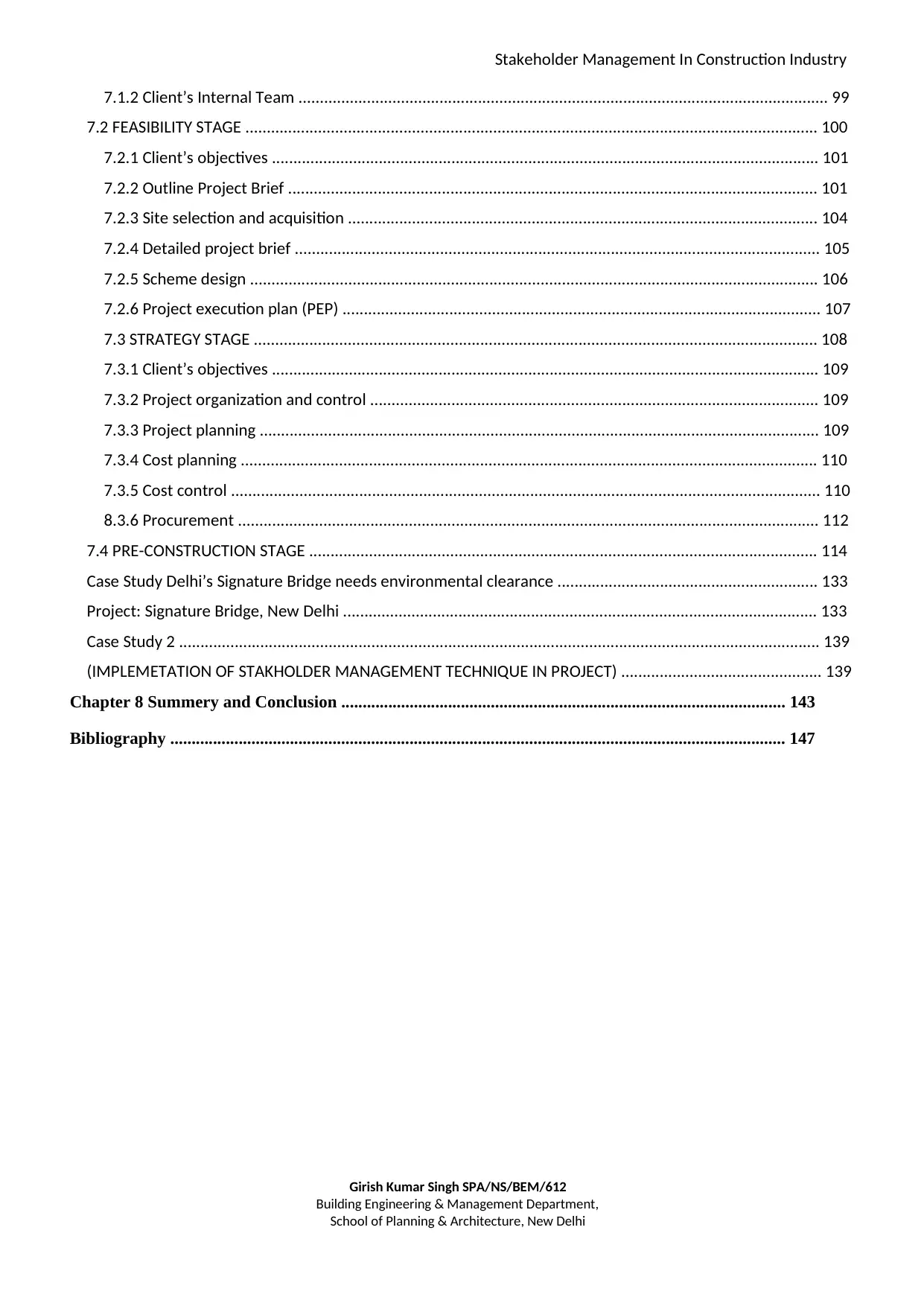
Stakeholder Management In Construction Industry
Girish Kumar Singh SPA/NS/BEM/612
Building Engineering & Management Department,
School of Planning & Architecture, New Delhi
7.1.2 Client’s Internal Team ............................................................................................................................ 99
7.2 FEASIBILITY STAGE ...................................................................................................................................... 100
7.2.1 Client’s objectives ................................................................................................................................ 101
7.2.2 Outline Project Brief ............................................................................................................................ 101
7.2.3 Site selection and acquisition .............................................................................................................. 104
7.2.4 Detailed project brief ........................................................................................................................... 105
7.2.5 Scheme design ..................................................................................................................................... 106
7.2.6 Project execution plan (PEP) ................................................................................................................ 107
7.3 STRATEGY STAGE .................................................................................................................................... 108
7.3.1 Client’s objectives ................................................................................................................................ 109
7.3.2 Project organization and control ......................................................................................................... 109
7.3.3 Project planning ................................................................................................................................... 109
7.3.4 Cost planning ....................................................................................................................................... 110
7.3.5 Cost control .......................................................................................................................................... 110
8.3.6 Procurement ........................................................................................................................................ 112
7.4 PRE-CONSTRUCTION STAGE ....................................................................................................................... 114
Case Study Delhi’s Signature Bridge needs environmental clearance ............................................................. 133
Project: Signature Bridge, New Delhi ............................................................................................................... 133
Case Study 2 ...................................................................................................................................................... 139
(IMPLEMETATION OF STAKHOLDER MANAGEMENT TECHNIQUE IN PROJECT) ............................................... 139
Chapter 8 Summery and Conclusion ........................................................................................................ 143
Bibliography ................................................................................................................................................ 147
Girish Kumar Singh SPA/NS/BEM/612
Building Engineering & Management Department,
School of Planning & Architecture, New Delhi
7.1.2 Client’s Internal Team ............................................................................................................................ 99
7.2 FEASIBILITY STAGE ...................................................................................................................................... 100
7.2.1 Client’s objectives ................................................................................................................................ 101
7.2.2 Outline Project Brief ............................................................................................................................ 101
7.2.3 Site selection and acquisition .............................................................................................................. 104
7.2.4 Detailed project brief ........................................................................................................................... 105
7.2.5 Scheme design ..................................................................................................................................... 106
7.2.6 Project execution plan (PEP) ................................................................................................................ 107
7.3 STRATEGY STAGE .................................................................................................................................... 108
7.3.1 Client’s objectives ................................................................................................................................ 109
7.3.2 Project organization and control ......................................................................................................... 109
7.3.3 Project planning ................................................................................................................................... 109
7.3.4 Cost planning ....................................................................................................................................... 110
7.3.5 Cost control .......................................................................................................................................... 110
8.3.6 Procurement ........................................................................................................................................ 112
7.4 PRE-CONSTRUCTION STAGE ....................................................................................................................... 114
Case Study Delhi’s Signature Bridge needs environmental clearance ............................................................. 133
Project: Signature Bridge, New Delhi ............................................................................................................... 133
Case Study 2 ...................................................................................................................................................... 139
(IMPLEMETATION OF STAKHOLDER MANAGEMENT TECHNIQUE IN PROJECT) ............................................... 139
Chapter 8 Summery and Conclusion ........................................................................................................ 143
Bibliography ................................................................................................................................................ 147
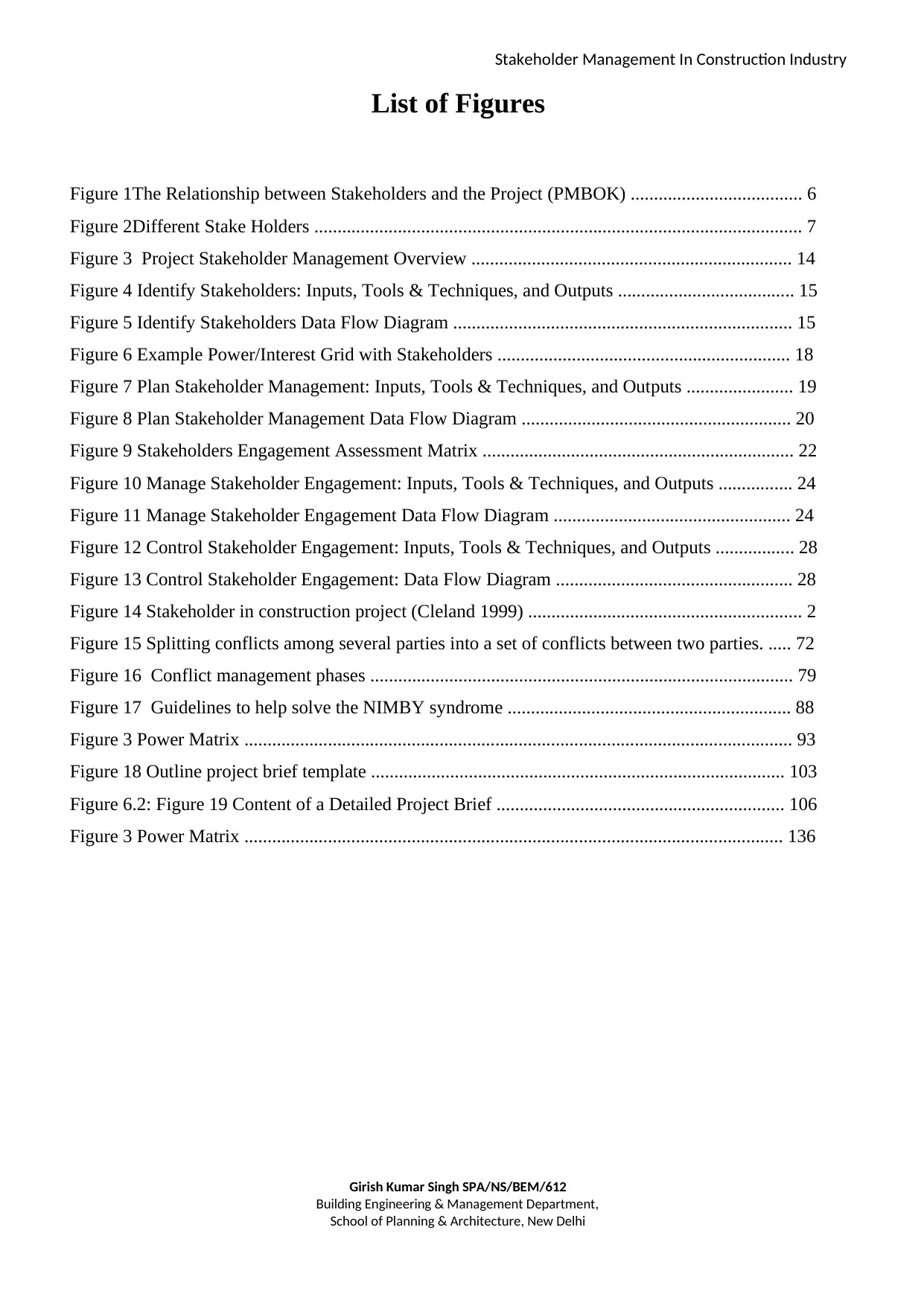
Stakeholder Management In Construction Industry
Girish Kumar Singh SPA/NS/BEM/612
Building Engineering & Management Department,
School of Planning & Architecture, New Delhi
List of Figures
Figure 1The Relationship between Stakeholders and the Project (PMBOK) ..................................... 6
Figure 2Different Stake Holders ......................................................................................................... 7
Figure 3 Project Stakeholder Management Overview ..................................................................... 14
Figure 4 Identify Stakeholders: Inputs, Tools & Techniques, and Outputs ...................................... 15
Figure 5 Identify Stakeholders Data Flow Diagram ......................................................................... 15
Figure 6 Example Power/Interest Grid with Stakeholders ............................................................... 18
Figure 7 Plan Stakeholder Management: Inputs, Tools & Techniques, and Outputs ....................... 19
Figure 8 Plan Stakeholder Management Data Flow Diagram .......................................................... 20
Figure 9 Stakeholders Engagement Assessment Matrix ................................................................... 22
Figure 10 Manage Stakeholder Engagement: Inputs, Tools & Techniques, and Outputs ................ 24
Figure 11 Manage Stakeholder Engagement Data Flow Diagram ................................................... 24
Figure 12 Control Stakeholder Engagement: Inputs, Tools & Techniques, and Outputs ................. 28
Figure 13 Control Stakeholder Engagement: Data Flow Diagram ................................................... 28
Figure 14 Stakeholder in construction project (Cleland 1999) ........................................................... 2
Figure 15 Splitting conflicts among several parties into a set of conflicts between two parties. ..... 72
Figure 16 Conflict management phases ........................................................................................... 79
Figure 17 Guidelines to help solve the NIMBY syndrome ............................................................. 88
Figure 3 Power Matrix ...................................................................................................................... 93
Figure 18 Outline project brief template ......................................................................................... 103
Figure 6.2: Figure 19 Content of a Detailed Project Brief .............................................................. 106
Figure 3 Power Matrix .................................................................................................................... 136
Girish Kumar Singh SPA/NS/BEM/612
Building Engineering & Management Department,
School of Planning & Architecture, New Delhi
List of Figures
Figure 1The Relationship between Stakeholders and the Project (PMBOK) ..................................... 6
Figure 2Different Stake Holders ......................................................................................................... 7
Figure 3 Project Stakeholder Management Overview ..................................................................... 14
Figure 4 Identify Stakeholders: Inputs, Tools & Techniques, and Outputs ...................................... 15
Figure 5 Identify Stakeholders Data Flow Diagram ......................................................................... 15
Figure 6 Example Power/Interest Grid with Stakeholders ............................................................... 18
Figure 7 Plan Stakeholder Management: Inputs, Tools & Techniques, and Outputs ....................... 19
Figure 8 Plan Stakeholder Management Data Flow Diagram .......................................................... 20
Figure 9 Stakeholders Engagement Assessment Matrix ................................................................... 22
Figure 10 Manage Stakeholder Engagement: Inputs, Tools & Techniques, and Outputs ................ 24
Figure 11 Manage Stakeholder Engagement Data Flow Diagram ................................................... 24
Figure 12 Control Stakeholder Engagement: Inputs, Tools & Techniques, and Outputs ................. 28
Figure 13 Control Stakeholder Engagement: Data Flow Diagram ................................................... 28
Figure 14 Stakeholder in construction project (Cleland 1999) ........................................................... 2
Figure 15 Splitting conflicts among several parties into a set of conflicts between two parties. ..... 72
Figure 16 Conflict management phases ........................................................................................... 79
Figure 17 Guidelines to help solve the NIMBY syndrome ............................................................. 88
Figure 3 Power Matrix ...................................................................................................................... 93
Figure 18 Outline project brief template ......................................................................................... 103
Figure 6.2: Figure 19 Content of a Detailed Project Brief .............................................................. 106
Figure 3 Power Matrix .................................................................................................................... 136
⊘ This is a preview!⊘
Do you want full access?
Subscribe today to unlock all pages.

Trusted by 1+ million students worldwide
1 out of 152
Related Documents
Your All-in-One AI-Powered Toolkit for Academic Success.
+13062052269
info@desklib.com
Available 24*7 on WhatsApp / Email
![[object Object]](/_next/static/media/star-bottom.7253800d.svg)
Unlock your academic potential
Copyright © 2020–2025 A2Z Services. All Rights Reserved. Developed and managed by ZUCOL.




